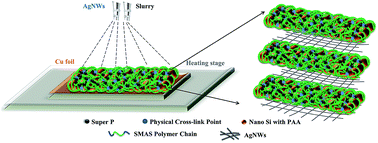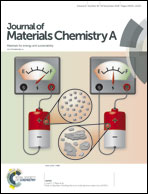Achieving a high loading Si anode via employing a triblock copolymer elastomer binder, metal nanowires and a laminated conductive structure†
Abstract
Low mass loading is a key issue waiting to be solved for practical applications of silicon anodes. Herein, a novel tri-block copolymer, polystyrene-poly(methyl acrylate)-polystyrene, is synthesized and used as a binder to form a cross-linked network to maintain the stability of an electrode and improve ion transportation. Silver nanowires are used as conductive additives to improve electron transportation. A laminated conductive structure is built by spraying layer upon layer to further enhance the electron transportation in a high Si mass loading anode. The achieved Si anode has the highest mass loading of 5.31 mg cm−2, which exhibits a stable capacity of 1609 mA h g−1 after 100 cycles. The areal capacity of 8.49 mA h cm−2 at this mass loading and the rate capability of 1146 mA h g−1 at 8400 mA g−1 (2C) with a mass loading of 1.69 mg cm−2 are all the highest records among the reported results to the best of our knowledge. Detailed calculations demonstrate that the power density can achieve 400 W h kg−1 for a full battery using such a Si anode and a commercially available cathode. The current design is also meaningful in manufacturing conventional graphite-anode lithium-ion batteries with both high energy and power density.



 Please wait while we load your content...
Please wait while we load your content...